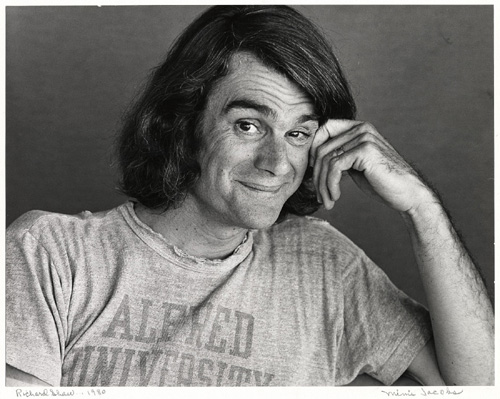 Photograph by Mimi Jacobs, photographer, 1971-1981. Archives of American Art, Smithsonian Institution. |
Richard Shaw | |
| Birth Date: 1941 |
||
Artist Gallery |
||
| A master of trompe l’oeil, ceramicist Richard Shaw creates highly realistic clay artworks of everyday objects in order to fool viewers into believing that they are looking at the actual objects themselves, rather than clay sculptures. Painters have been using the illusionistic trompe l’oeil (deceive the eye) technique for millennia, but it became popular with ceramists in the early 1970s. Shaw was attracted to trompe l’oeil and the ceramic traditions of Europe and Asia in the 1700s.
Shaw’s parents were both artists, his mother a painter and his father an animator at Walt Disney. He began his art education by attending Orange Coast College followed by the San Francisco Art Institute where he received his B.F.A. in 1965. He continued his studies at State University of New York at Alfred, Alfred, NY, and finally at University of California at Davis, receiving an M.F.A. in 1968. At San Francisco Art Institute, Shaw was influenced by professors Ron Nagle, Jim Melchert, Peter Voulkos and John Mason. His interest in ceramics began in 1963, when he began experimenting with new firing techniques. Expanding his horizons, he applied for and received a National Endowment for the Arts grant to explore photo silk-screening for reproducing decals. The grant enabled him to work as a professional silkscreen artist and to develop low-fire ceramic inks and transfer decals. The results of this advance can be seen in his representations of stamps, labels, playing cards, and other elements that add depth to his work.
Shaw is recognized as a leading force in the development and direction of ceramics in the last half of the twentieth century. He has pushed the edge of ceramic art to incorporate techniques not usually associated with clay such as silk screening, and in doing so, has helped elevate clay from a craft form to fine art.
Shaw has been making and using plaster molds for casting his everyday objects since the 1960s, and his studio in Fairfax, California contains hundreds of them. He has always collected “junk,” bits and pieces that catch his eye, and almost all end up being cast. While his assemblages often seem loosely piled together, he begins with numerous sketches, moving through a very careful, thought-out development. Shaw does not provide all the answers to the meaning behind his work, but leaves the impression of a “mysterious event posing a question rather than handing out an answer.”
Shaw’s ceramics can be found in major collections across the country, including the Smithsonian’s National Museum of American Art in Washington, D.C., and the Whitney Museum of American Art in New York, as well as in collections in Europe and Japan. Shaw is currently an art professor at the University of California, Berkeley.
|
||


